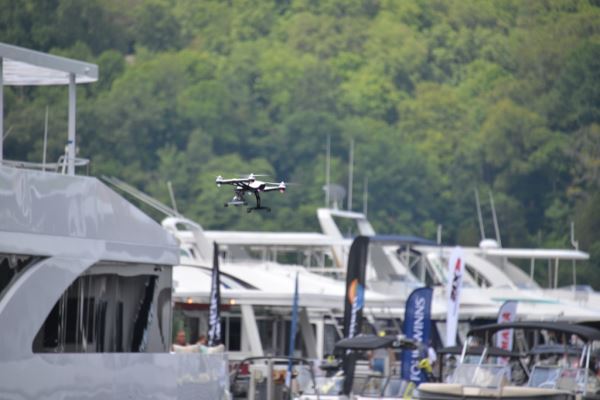
The FAA estimated that more than a million drones would be sold over the Christmas holiday. Since I insure drones, I thought I might talk a little about the drone world and boating.
I know you are probably scratching your head, thinking, “Drones?” But hang in there while I drone on.
Many people think of drones as a nuisance, little noisy flying machines intruding on our privacy, agitating our calm and quiet airspace. Well, yes, they can be. But from a boater and a pilot’s view, they can be fun to use and maybe even valuable.
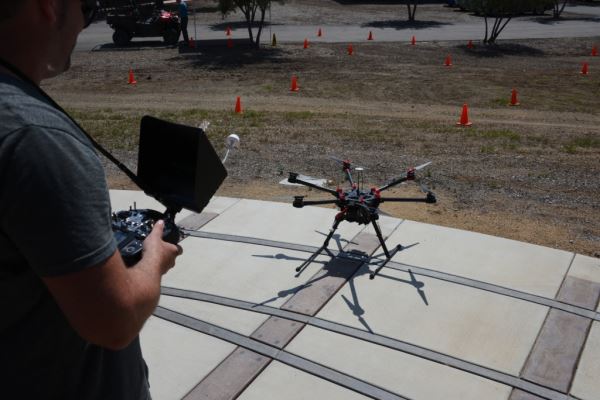 Good and bad, drones have been in the news. In December, the FAA announced that all drones over 250 grams (just under 9 ounces) would need to be registered. They hope that the registration will help educate people about the rules when flying a drone, and give them a way to track down a wayward drone. In reality, at the time I was writing this column, the website to register still wasn’t working as it was supposed to. If and when the registration does work, good luck to the FAA trying to get people to register.
Good and bad, drones have been in the news. In December, the FAA announced that all drones over 250 grams (just under 9 ounces) would need to be registered. They hope that the registration will help educate people about the rules when flying a drone, and give them a way to track down a wayward drone. In reality, at the time I was writing this column, the website to register still wasn’t working as it was supposed to. If and when the registration does work, good luck to the FAA trying to get people to register.
In my case, we are already registered because we want to use our drone as a commercial operator, meaning we want to get paid to fly our drone and take pictures or videos. Currently, to use a drone as a commercial operator, you have to file for an FAA exemption from the standard aircraft rules. It is kind of an overwhelming process and will take months before the FAA approves us. So far there are over 2,900 companies approved, and there are probably ten thousand or more that have sent in their request like us. It takes a while for the FAA to get through the paperwork and issue approvals. I hope by the time you read this, I’ll have my approval.
Where do drones fit into the boating and pontoon segment of the recreational world? Well, I think it is back to the numbers game. I was a speaker and moderator at a drone convention in September 2015. At that time it was estimated that one of the major companies sells 15,000 drones per day.
Additionally, one of the keynote speakers (another major manufacturer) looks at drones like the internet. Basically, the thought is if you can remember when the internet started, most business looked at ways to use the internet and they all had an idea and the market grew exponentially. Same for drones. Figure out how a business (and this is not even the big ones like Amazon, Wal-Mart, or Google) can use a drone and bingo: the market is growing exponentially.
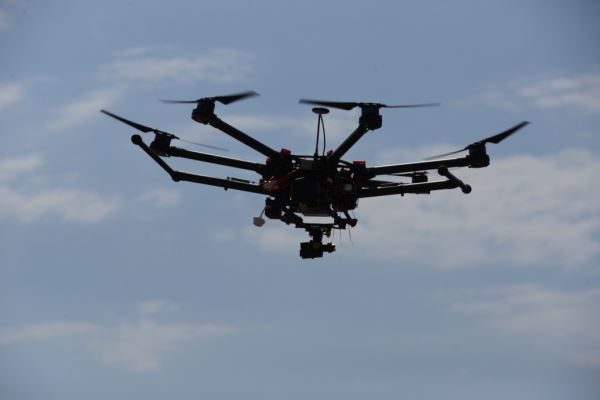
Or you can think of it like cell phones. Few people had them at first (most thought of it as an expensive fad) and would never replace their landline phone. Now it’s reversed and very few people even have a landline.
With millions of drones, what are people doing with them? As commercial operators I understand the use. Photos, videos surveys, inspections and more. But as a private owner, how many family photos can I take hovering over my back yard patio?
Let’s think about this for a moment. Again, hobbyist use is just fun flying experiences and unique photo opportunities. But it can be a lot more. Farmers and ranchers are looking at crops and livestock with drones. Infrared cameras on drones can tell the farmer or rancher if one of the herd has a different heat signature and if they should be singled out for medical attention. A drone can help look for wet or dry areas in a field or if an area needs to be replanted.
Hunters are using drones to look for game trails and herd locations. I think hunting with a drone is illegal everywhere, but I don’t think spotting is. Don’t take my word on it, though. I haven’t been into hunting for years. You need to check the laws.
But there is more: now there are power companies using drones to check their power lines. Oil and gas companies are using drones to make inspections on wells and pipelines. Wind generator companies are using drones to inspect wind mills. The list goes on, including law enforcement, search and rescue, research, surveyors and even claims adjustors.

But all these ideas got me to thinking about my ‘toon. Wouldn’t it be cool to fly a circle around the ‘toon and take a few aerial shots of the boat in the water? What about photos of the boat as we motored across the lake, drone and a camera following us?
Another thought: what about those water sports (tubing or wakeboards) being recorded from the air? Even the local yacht club thinks they would like to have a few shots as the sailors cross the finish line in a local race.
And what about fishing? Is that legal? I watched a video in New Zealand where the drone took a fisherman’s line and bait out past the surf and dropped it in the water. Could I chum from the air? Or maybe I could use it to spot schools from my boat. Remember, I am not big into fishing or hunting so I have no idea if any of these ideas are even legal.
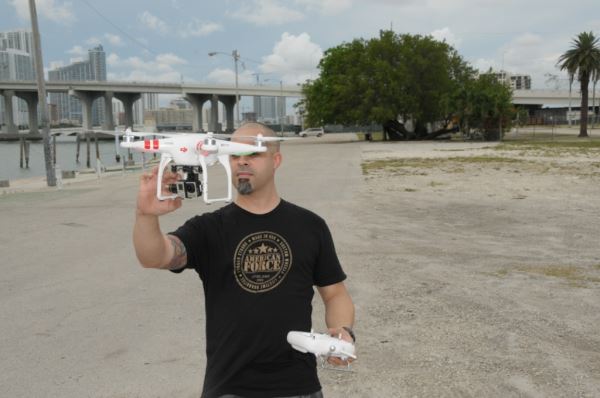 It sounds fun to me. But wait, I just had a thought: most drones don’t like the water. They are electric flying computers that short out and quit working when wet. So, that means I either need a drone that can land on the water or a waterproof drone.
It sounds fun to me. But wait, I just had a thought: most drones don’t like the water. They are electric flying computers that short out and quit working when wet. So, that means I either need a drone that can land on the water or a waterproof drone.
Additionally, even though we keep getting better at flying the drones and even if the drones have a return home button, neither of those things guarantees that I can land the drone back on the ‘toon in the middle of the lake. What are the boater’s options for droning?
Well, I discovered there are a couple of options. Take a regular drone and attach a few of those foam noodles to the landing gear and hope the waves won’t flip it over. That idea wasn’t at the top of my list; I put too much money in a drone to have it ruined in hard landing on the water.
The second option I found was one I really liked. It’s called the Splash Drone. Yes, I did buy one. It looks like a regular quad copter drone (four rotors) but it is waterproof. It uses a GoPro camera (or its own GoPro Clone) mounted in a waterproof case. The drone will actually float and land on the water and take back off. I’m thinking this is the ‘toon owner’s equivalent to the “cat’s meow.” Okay, that was a bad joke, but really, it has all the things I need. A camera, it’s waterproof, it floats and if I miss landing back on the ‘toon, it won’t turn into an expensive submarine.
Our video production company (my son) has put the unboxing ceremony on YouTube and when we get some nice weather we will make a few test flights. The model I bought has an external load drop hook so I could, in theory, drop a fishing line or a very small life preserver from my drone. Guess that could make it even more valuable. Anyway, I’ll let you know if it works as good as I hope. I’m looking forward to flying circles around my ‘toon this year!
As a side note, there are drones that don’t fly and are designed to run on the surface and under water. If you are into diving take a look at the HydroView MAX Remote Operated Underwater Vehicle. I am not involved with or promoting this unit, but it sure looks cool, although I think it was priced over $5,000.
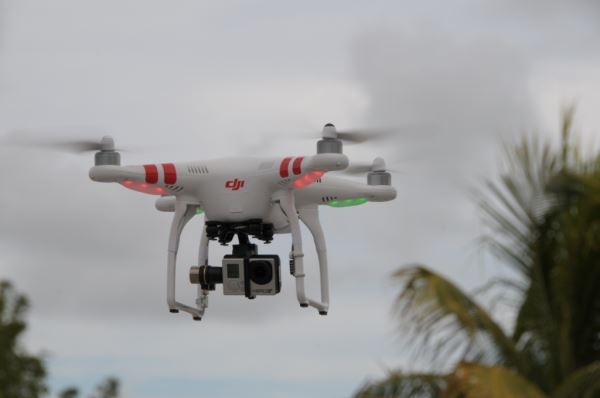 On another side note, if you like flying and have ever wanted to race an aircraft do an internet search for FPV racing. This is First Person View racing and is becoming an international sport. It uses small drones designed for speed with a camera on board and you fly the drone by seeing what the camera sees. It’s like riding in the drone. Operators have goggles with small screens in them that give them the view. Races are done in fields, in parking garages, forests and abandoned buildings. And yes, I bought one of these too. I hope to be able to fly it soon.
On another side note, if you like flying and have ever wanted to race an aircraft do an internet search for FPV racing. This is First Person View racing and is becoming an international sport. It uses small drones designed for speed with a camera on board and you fly the drone by seeing what the camera sees. It’s like riding in the drone. Operators have goggles with small screens in them that give them the view. Races are done in fields, in parking garages, forests and abandoned buildings. And yes, I bought one of these too. I hope to be able to fly it soon.
If you don’t like the thought of a drone flying over you, your house or your boat, and are thinking you might just shoot it down, think twice. Some feel it is illegal because it is an aircraft. Others feel that if it’s over private space like a yard or house it can become a target practice. Recently a judge overturned a case where a person shot a drone because it was spying on his yard and daughters. But there is a lot of grey area as to what is personal space. Some feel that any airspace above ground is airspace managed by the FAA. Others feel airspace doesn’t start until the navigation space, whatever that is. State and local laws would need to be considered also.
Now it’s time for a little safety and education.
When I’m talking about drones, I am talking about sUAV (small Unmanned Aerial Vehicles). The FFA likes to use the term sUAS, (Unmanned Aerial Systems). Sometimes they are called RPV (Remotely Piloted Vehicles). But in the end, most people just call them drones.
Some of the most important drone rules are:
- Fly below 400 feet altitude
- Keep your unmanned aircraft in sight at all times
- Never fly near manned aircraft, especially near airports
- Never fly over groups of people, stadiums or sporting events
- Never fly near emergency response efforts
If you want to learn more about how you can use a drone for fun, go to the “Know before you fly” website at http://knowbeforeyoufly.org/.
It’s also important to review the information at the Academy of Model Aeronautics (AMA) website about models. Their website is http://www.modelaircraft.org/
If you want to know more about how the Splash Drone works, send me an email and I’ll update you as we go.
Scott “Sky” Smith is the author of “Ultimate Boat Maintenance Projects” and an independent agent insuring boats, custom vehicles, drones and aircraft nationwide. Sky@SkySmith.com. Follow on Twitter @scottskysmith.

